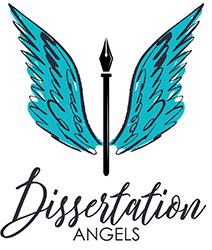Hey scholars! In this post, I give a brief run-down on what to include in the 5 chapters of a dissertation. I describe the order of the dissertation chapters and the contents of each. Bear two things in mind: 1) not all programs follow a 5-chapter format, so check with your school’s template or handbook; and 2) the titles of each chapter may differ depending on your program’s requirements.
Now, let’s get this party started.
Chapter 1: Introduction

The first chapter of a dissertation serves to introduce the project to your reader. Chapter 1 is the most important chapter because it’s the “nuts and bolts” of your project, laying the foundation for your entire study! Typical sections of Chapter 1 may include background of the problem, problem statement, purpose statement, research questions, significance, limitations/delimitations, nature of the study, and key terms.
When writing Chapter 1, be very mindful of alignment between the sections. The chapter should feel like a jigsaw puzzle with pieces that perfectly fit together. Your verbiage should be *very similar* across the problem statement, purpose statement, and research questions, especially.
The introduction chapter can feel painfully redundant, but it’s designed to. Don’t try to get fancy by switching up your language – consistency is the name of the game! Also, avoid channeling your inner Shakespeare when working on your dissertation; academic writing is concise. The Purdue Owl has a great article on how to improve the concision of your writing.
One last thing: make sure you’ve got a solid grasp on your research direction before you start hammering out Chapter 1. It’s helpful to create a prospectus or foundations document that will guide you through the development of Chapter 1.
Chapter 2: Literature Review

Chapter 2 is your literature review, and it’s is designed to do three things: 1) conceptualize your research, 2) expose the gap your study will address, and 3) test your resolve. On average, a literature review is 30-50(ish) pages dedicated to discussing what’s known and unknown, relative to your topic. Take a funnel approach to the literature review – work from the broad to the specific and focus on the research most relevant to your topic. If your dissertation topic is chocolate cake, you may have an overview section on the history of desserts, the origin of cake, and different cake flavors – but you probably wouldn’t want to include too much research on specific types of fudge or strudel. Does that make sense or am I just hungry?
Chapter 2 may also include a section dedicated to describing your search strategy, theoretical or conceptual framework, and the research gap. Don’t let the literature review overwhelm you, just think of it as a long research paper. Stay organized, keep track of your resources, and chunk it down. If you just write 2 pages per day, you could have a complete, polished literature review in a month!
Chapter 3: Method

The third chapter is the most formulaic of the dissertation: your methods chapter. In Chapter 3, you provide a blueprint of what you’re going to do. Think of it this way:
1. Chapter 1 explains what your study is about and why it’s important;
2. Chapter 2 highlights what’s known, what remains unknown, and how your study will address the knowledge gap; and
3. Chapter 3 details exactly how you intend to perform your research to address that gap.
Sections we typically see in Chapter 3 include method, design, instrumentation, population/sample/sample size, recruitment, data sources, data collection, data analysis, trustworthiness (for qualitative studies), validity/reliability (for quantitative studies), and ethical procedures. When you’re writing Chapter 3, focus on the details. Assuming your reader has no background on your research, Chapter 3 should be laid out so clearly that once they finish reading it, they could replicate your study with precision. One of the biggest challenges I see with Chapter 3 drafts is a lack of detail – there should be no questions about what you’re doing. Make everything crystal clear! Read more about choosing between qualitative and quantitative methods here.
Chapter 4: Dissertation Results

After the first three chapters of your dissertation are approved and you’ve secured necessary research permissions (IRB, HRSC, etc.), you’ll collect and analyze your data. The results of your analysis are presented in Chapter 4. The sections of the results chapter will depend on whether your research is qualitative or quantitative (or mixed), but may include a description of the sample, details of how the analysis was conducted, any deviations from the plan described in Chapter 3, a summary of your findings, and a detailed analysis for each of the research questions.
Chapter 5: Discussion

Chapter 5 – you made it! This is the most fun chapter to write because you have the most freedom in Chapter 5. The goal of your discussion chapter is to interpret the results and answer the SO WHAT question. Chapter 4 was a presentation of your findings, and Chapter 5 is a discussion of what those findings mean. In this chapter, you’ll recap study results and then provide a discussion of your findings in context of previous literature. How did your results confirm or challenge results from other investigations? Did your findings provide unique insights? Perhaps your results just created more questions – that’s okay too!
In addition to a discussion of study results, Chapter 5 often includes sections on practical and theoretical implications, recommendations for practice, and recommendations for future research. In terms of your chapter 5 dissertation length, aim for 15-20 pages.
Wrap-up
Phew! We made it! I know the dissertation can seem like a mindbender, but it needn’t be. Just take it one section at a time and know the process will probably involve more revisions and changes than you anticipated. Writing the five chapters of a dissertation is a marathon, not a sprint, but the finish line is never as far away as it feels ?
Take a look at recently published dissertations from other scholars in your program, or sign up for my email list to receive a sample dissertation pdf file, which provides a more in-depth roadmap for your journey. Also, check out my other posts on common APA errors to avoid and ways to overcome dissertation procrastination!
Happy writing!
